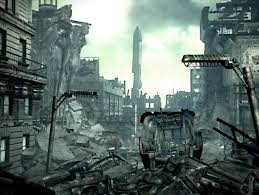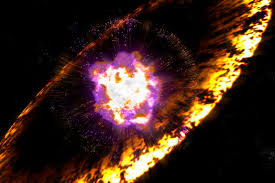
By, kt.ty
Imagine what would happen if one morning, you woke up and heard of the news that the earth has stopped in its orbit or a planet went out of orbit and destroyed the earth, along with the entire human race. Thankfully, this occurrence is quite impossible. Both the fiction (The Star and There Will Come Soft Rains) and nonfiction stories (What Would Happen if the Earth Stopped In Its Orbit and What if Saturn Paid Us A Very Close Visit) seem to display that it is impossible for another planet to collide with earth. This is because of its immense gravitational pull.
The books, There Will Come Soft Rains and The Star both revolve around humans being wiped out, or should I say almost wiped out. In the story There Will Come Soft Rains, humans die from a nuclear war but the futuristic house that the humans once lived in still operates as if the humans lived there. In the story The Star, one of Neptune’s stars fall into Earth’s orbit and barely misses us. As the star gets closer, panic arises throughout planet earth. In the end, most of Earth’s population dies. However, the few that do survive witness an eclipse implying that the star has passed. Despite the world almost coming to an end, human life goes back to normal with a few slight changes to the planet.
Despite these stories, there are specific non-fictional articles which one can use in disapproval. An example would be in the article What if Saturn Paid us a Very Close Visit. The animation group, Yeti Dynamics, has created an animation displaying what it would look like if Saturn fell into our orbit. However, Saturn’s gravity would create utter havoc on earth, causing the animator to completely forget about the gravity aspect. Don’t forget that its orbit is huge and very circular, so it will never get any closer than about a million kilometers. This article is not the only article in disapproval, as there is another article called What Would Happen If The Earth Stopped In Its Orbit. The article speaks about what would happen if a “giant finger” stopped the Earth in its orbit. If this were to happen, Earth would fall into a perpetual free fall. It would only take 64½ days to fall into the sun, and we wouldn’t even survive the whole 64½ days. Luckily, there is no giant finger to stop our orbit.
From the information that’s been collected, I can come to the conclusion that I am very glad that these ideas are impossible. It’s very nice to know that science has proven that one of my worst fears cannot actually happen. At first, after reading the stories, I was scared of the answer science would give. In the end, however, I can happily call it something merely in my imagination. Despite being a fun topic to think about, I am thankful that these stories have not, and will not become reality.
In conclusion, I can finally say that the made up frights in the short stories There Will Come Soft Rains and The Star are only fake ideas, due to the disapproval of the articles What Would Happen if the Earth Stopped in Its Orbit and What if Saturn Paid Us A Very Close Visit. However, as a reader, would you want the earth to stop in its orbit or a planet to go out of orbit and destroyed the earth, along with the entire human race? While reading a story, the reader always wants the thrill to keep the story from being boring. But would you want a thrill like this to happen in real life?!

